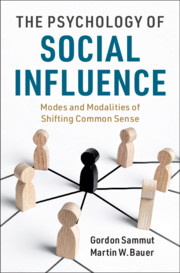Book contents
- The Psychology of Social Influence
- The Psychology of Social Influence
- Copyright page
- Dedication
- Contents
- Figures
- Tables
- Boxes
- Foreword 1
- Foreword 2
- Acknowledgements
- Chapter 1 Modalities of Social Influence
- Part I Recurrent Sources of Populism
- Part II Experimental Paradigms
- Part III Necessary Extensions
- Chapter 8 Agenda Setting, Framing and Mass Mediation
- Chapter 9 Designing and Resisting Artefacts
- Part IV Theoretical Integration
- References
- Index
Chapter 9 - Designing and Resisting Artefacts
from Part III - Necessary Extensions
Published online by Cambridge University Press: 19 December 2020
- The Psychology of Social Influence
- The Psychology of Social Influence
- Copyright page
- Dedication
- Contents
- Figures
- Tables
- Boxes
- Foreword 1
- Foreword 2
- Acknowledgements
- Chapter 1 Modalities of Social Influence
- Part I Recurrent Sources of Populism
- Part II Experimental Paradigms
- Part III Necessary Extensions
- Chapter 8 Agenda Setting, Framing and Mass Mediation
- Chapter 9 Designing and Resisting Artefacts
- Part IV Theoretical Integration
- References
- Index
Summary
Chapter 9 examines a second necessary extension of the analysis of social influence to a consideration of the effects of designed artefacts in social relations. The chapter starts with an elaboration of the notion of inter-objectivity: designed hardware permeates human social relations as infrastructure, tools, gadgets and instruments. How is different hardware used to implement modalities of social influence? Crowds have historically used barricades to enhance their power. People easily recognise the fait accompli, for example as a wall, installed in a collective effort of construction. Such installations provide boundaries and parameters of attitudes and behaviour afforded by design, but do so without prior consent. Legitimation is achieved post-hoc by cognitive dissonance in analogy to forced-compliance. Resistance to such faits accompli is introduced as a hitherto unrecognised modality of social influence. It functions to evaluate and to redesign hardware and systems in ways that correct the initial designs; resistance potentially innovates on the 'innovation'.
Keywords
- Type
- Chapter
- Information
- The Psychology of Social InfluenceModes and Modalities of Shifting Common Sense, pp. 188 - 214Publisher: Cambridge University PressPrint publication year: 2021



